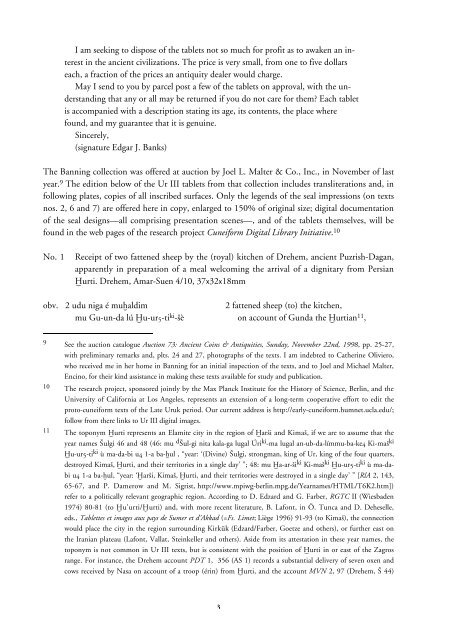PDF copy - Cuneiform Digital Library Initiative - UCLA
PDF copy - Cuneiform Digital Library Initiative - UCLA
PDF copy - Cuneiform Digital Library Initiative - UCLA
Create successful ePaper yourself
Turn your PDF publications into a flip-book with our unique Google optimized e-Paper software.
I am seeking to dispose of the tablets not so much for profit as to awaken an interest<br />
in the ancient civilizations. The price is very small, from one to five dollars<br />
each, a fraction of the prices an antiquity dealer would charge.<br />
May I send to you by parcel post a few of the tablets on approval, with the understanding<br />
that any or all may be returned if you do not care for them? Each tablet<br />
is accompanied with a description stating its age, its contents, the place where<br />
found, and my guarantee that it is genuine.<br />
Sincerely,<br />
(signature Edgar J. Banks)<br />
The Banning collection was offered at auction by Joel L. Malter & Co., Inc., in November of last<br />
year. 9 The edition below of the Ur III tablets from that collection includes transliterations and, in<br />
following plates, copies of all inscribed surfaces. Only the legends of the seal impressions (on texts<br />
nos. 2, 6 and 7) are offered here in <strong>copy</strong>, enlarged to 150% of original size; digital documentation<br />
of the seal designs—all comprising presentation scenes—, and of the tablets themselves, will be<br />
found in the web pages of the research project <strong>Cuneiform</strong> <strong>Digital</strong> <strong>Library</strong> <strong>Initiative</strong>. 10<br />
No. 1 Receipt of two fattened sheep by the (royal) kitchen of Drehem, ancient Puzrish-Dagan,<br />
apparently in preparation of a meal welcoming the arrival of a dignitary from Persian<br />
Îurti. Drehem, Amar-Suen 4/10, 37x32x18mm<br />
obv. 2 udu niga é muÌaldim 2 fattened sheep (to) the kitchen,<br />
mu Gu-un-da lú Îu-ur5-ti ki -Òè on account of Gunda the Îurtian 11 ,<br />
9 See the auction catalogue Auction 73: Ancient Coins & Antiquities, Sunday, November 22nd, 1998, pp. 25-27,<br />
with preliminary remarks and, plts. 24 and 27, photographs of the texts. I am indebted to Catherine Oliviero,<br />
who received me in her home in Banning for an initial inspection of the texts, and to Joel and Michael Malter,<br />
Encino, for their kind assistance in making these texts available for study and publication.<br />
10 The research project, sponsored jointly by the Max Planck Institute for the History of Science, Berlin, and the<br />
University of California at Los Angeles, represents an extension of a long-term cooperative effort to edit the<br />
proto-cuneiform texts of the Late Uruk period. Our current address is http://early-cuneiform.humnet.ucla.edu/;<br />
follow from there links to Ur III digital images.<br />
11 The toponym Îurti represents an Elamite city in the region of ÎarÒi and KimaÒ, if we are to assume that the<br />
year names ∑ulgi 46 and 48 (46: mu d ∑ul-gi nita kala-ga lugal Úri ki -ma lugal an-ub-da-límmu-ba-ke4 Ki-maÒ ki<br />
Îu-ur5-ti ki ù ma-da-bi u4 1-a ba-Ìul , “year: ‘(Divine) ∑ulgi, strongman, king of Ur, king of the four quarters,<br />
destroyed KimaÒ, Îurti, and their territories in a single day’ ”; 48: mu Îa-ar-Òi ki Ki-maÒ ki Îu-ur5-ti ki ù ma-dabi<br />
u4 1-a ba-Ìul, “year: ‘ÎarÒi, KimaÒ, Îurti, and their territories were destroyed in a single day’ ” [RlA 2, 143,<br />
65-67, and P. Damerow and M. Sigrist, http://www.mpiwg-berlin.mpg.de/Yearnames/HTML/T6K2.htm])<br />
refer to a politically relevant geographic region. According to D. Edzard and G. Farber, RGTC II (Wiesbaden<br />
1974) 80-81 (to Îu'urti/Îurti) and, with more recent literature, B. Lafont, in Ö. Tunca and D. Deheselle,<br />
eds., Tablettes et images aux pays de Sumer et d’Akkad (=Fs. Limet; Liège 1996) 91-93 (to KimaÒ), the connection<br />
would place the city in the region surrounding Kirkºk (Edzard/Farber, Goetze and others), or further east on<br />
the Iranian plateau (Lafont, Vallat, Steinkeller and others). Aside from its attestation in these year names, the<br />
toponym is not common in Ur III texts, but is consistent with the position of Îurti in or east of the Zagros<br />
range. For instance, the Drehem account PDT 1, 356 (AS 1) records a substantial delivery of seven oxen and<br />
cows received by Nasa on account of a troop (érin) from Îurti, and the account MVN 2, 97 (Drehem, ∑ 44)<br />
3
















